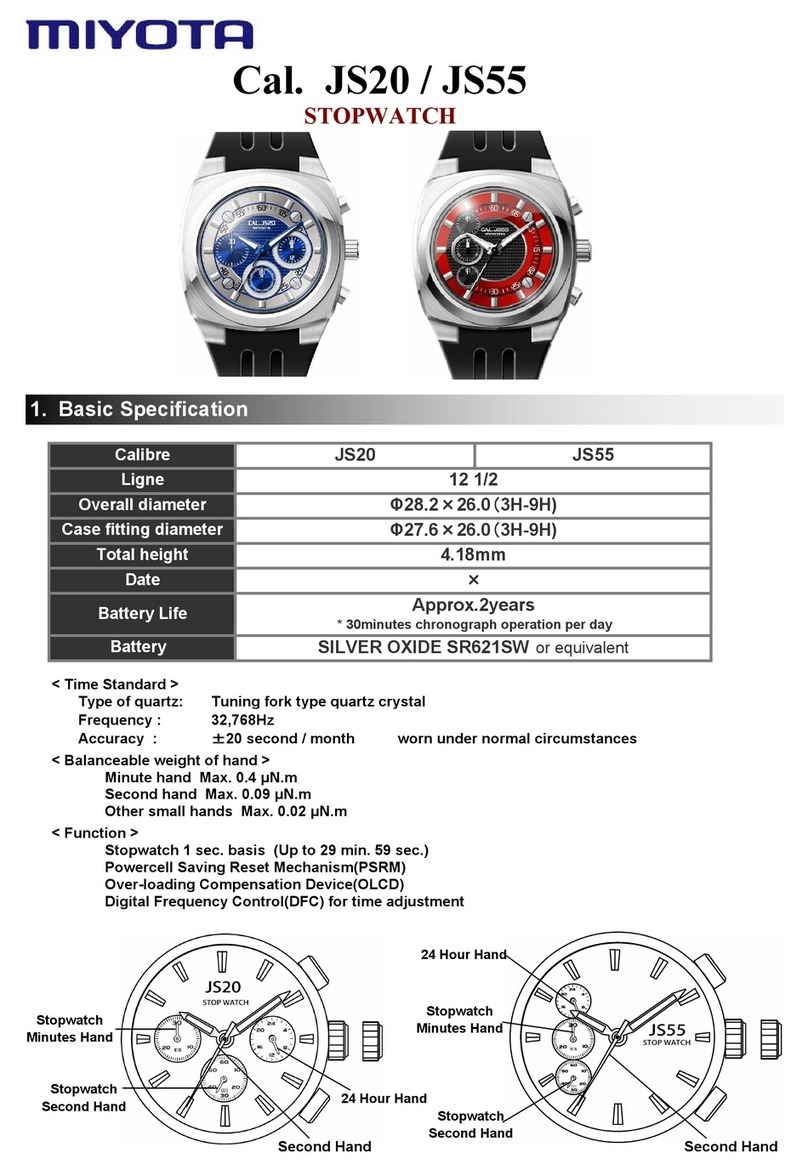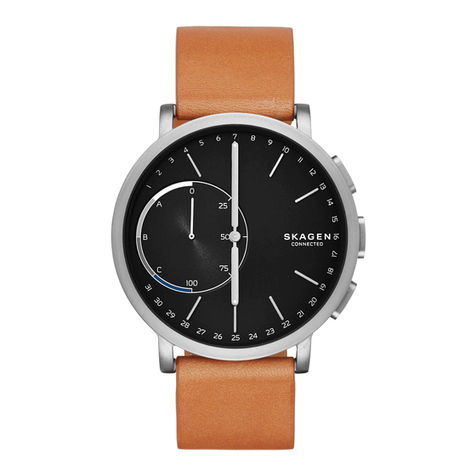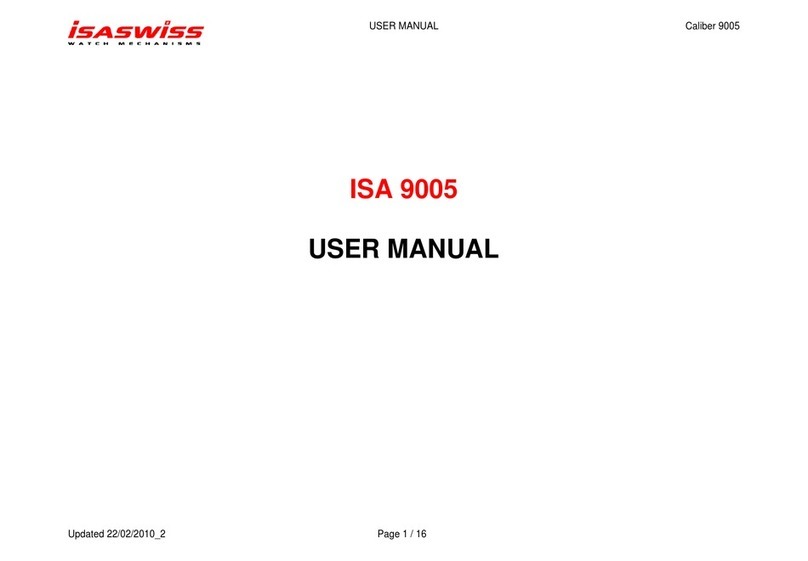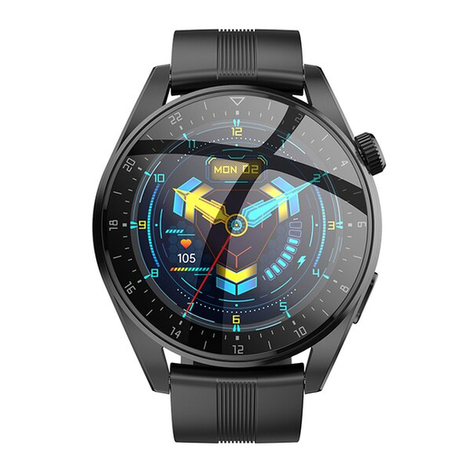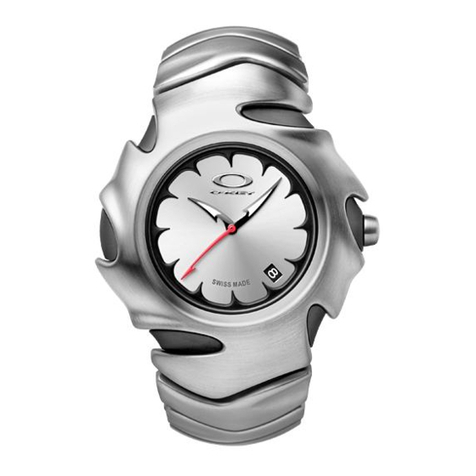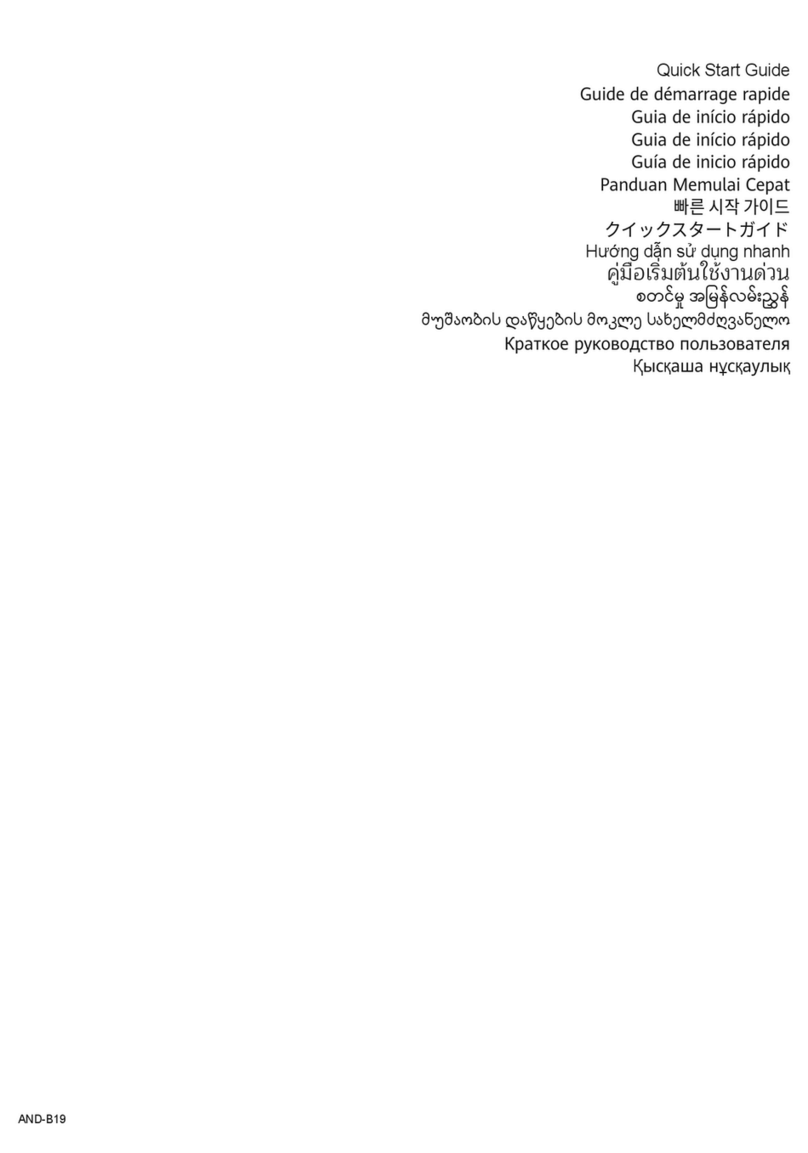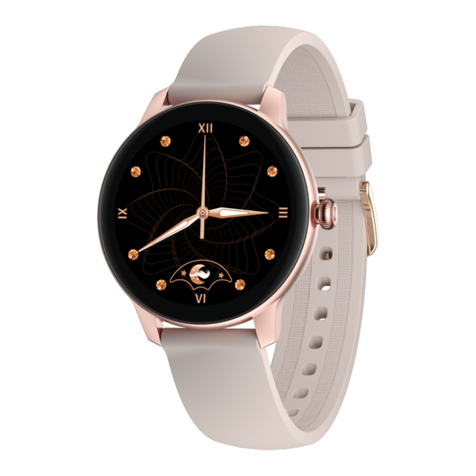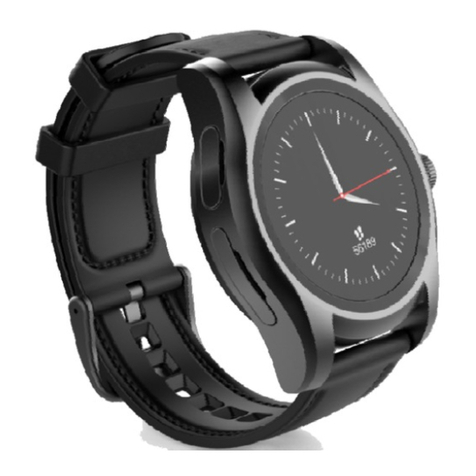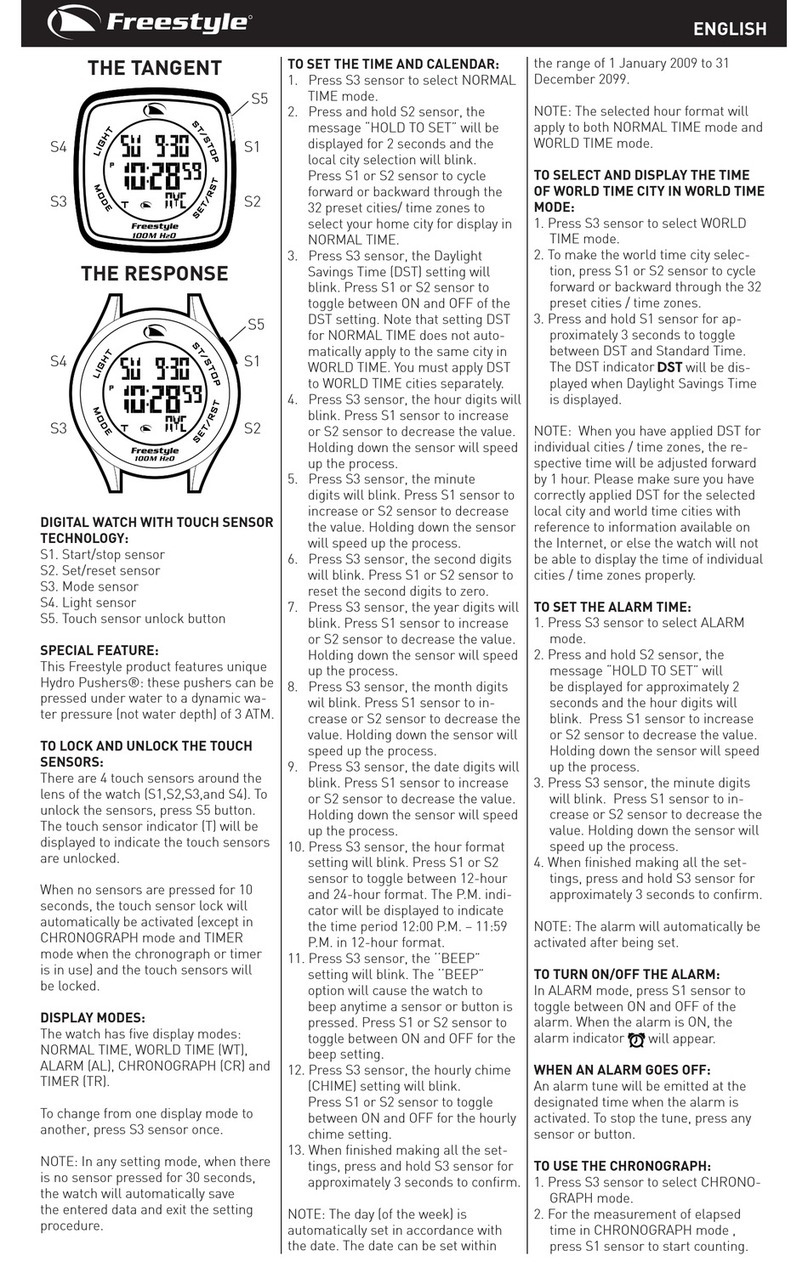Citizen H461 User manual

2
WThis watch is a radio wave watch that W
receives the standard time radio wave
transmitted in Germany.
This radio wave watch is equipped with a regular automatic reception
function that sets the time and date by automatically receiving radio
waves twice a day at 3:00 AM and 4:00 AM, and a free reception
function that allows the time to be set arbitrarily by receiving radio
waves. A time difference can also be set in 1 hour units based on
German standard time.
3
English
The design may differ according to the model.
Hour hand
Button (B)
Minute hand
H,M,L:
Reception level/
Reception result
Second hand
No: Reception result
SET:
Indicated when a
time difference has
been set
±0:
Indicated when
no time
difference has
been set
Button (A)
Crown
Shorter end of
second hand RX:Reception standby
(start of radio wave reception)
Crown for turning
the outer scale
L
This watch indicates the reception level and reception result with the shorter end of the second hand.

4 5
· This watch only receives the standard time radio wave transmitted in
Germany during radio wave reception. It is unable to receive radio
waves of countries other than Germany.
· When using the watch in a location that has a different time
difference than that of Germany, set the time difference by referring
to the section entitled, “5. Time Difference Correction Function”. If
the standard time radio wave transmitted in Germany is received after
setting the time difference by another method, the time will return to
German standard time.
WPlease use this watch afterW
charging sufficiently by
placing in light.
If the second hand of the watch is moving at two-second intervals
while the watch is in use, this indicates that the watch is insufficiently
charged. Use the watch after first recharging by placing the watch
under direct sunlight for about 8 hours. To ensure that this Eco-Drive
Radio Wave Watch is used comfortably without stopping, it is
recommended to try to keep the watch fully charged at all times.

76
WPlease confirm the following before usingW
the watch.
Check the
movement of the
second hand.
Recharge the watch by
placing under direct sunlight
Check the
reception
result.
When the shorter end
of the second hand has
pointed to reception
result (NO)
When the shorter
end of the second
hand has pointed to
a reception result
(H, M, L)
Perform radio wave reception by
referring to “Free Reception”described
in the section on “Important Points
Regarding Radio Wave Reception”.
The standard time
radio wave has been
received properly.
The watch can now
be used.
RX:Reception
standby
H,M,L:
Reception level /
reception result NO: Reception
result
Button (A)
Second hand
moving at 1-
second intervals
Second hand moving at
2-second intervals
Second hand moving at 1-second intervals
Press button (A)
(located at the 4:00
position) once.

WImportant Points Regarding Radio Wave
ReceptionW
The two ways to receive radio waves that are ordinarily used
consist of Regular Automatic Reception and Free Reception.
When receiving radio waves, first remove the watch from your
wrist, face the 9:00 position on the watch towards the radio wave
transmitter station, and place the watch in a stable location that
facilitates reception of radio waves such as in front of a window.
Since the watch uses a directional antenna, moving the watch
while reception is in progress may prevent radio waves from
being properly received. When reception
is completed, the second hand returns to
one-second interval movement. Do not
move the watch until radio wave
reception is completed.
8 9
[Regular Automatic Reception]
The watch sets the time and date by automatically receiving radio waves at the
predetermined times of 3:00 AM and 4:00 AM each day.
<Confirmation of Reception>
Check the reception result to determine whether or not radio waves have been
received properly by pressing button (A) located at the 4:00 position once. If the
shorter end of the second hand points to H, M or L, this indicates that radio waves
have been received properly. The watch can now be used.
If the shorter end of the second hand points to NO at the 5:00 position, this means
that radio waves were unable to be received properly. If this happens, perform
radio wave reception using the Free Reception function.
[Free Reception]
The Free Reception function lets you receive radio waves at any time. Use this
function when the reception environment has changed or in other cases when radio
waves are unable to be received by Regular Automatic Reception.

11
W
When Storing in a Dark Location for a Long
Period of TimeW
If the watch is stored in a location out of the light for a period of one week or more,
the Power Save Function of the watch is activated and the watch stops. Even
though the watch is in the Power Save mode, it still continues to perform Regular
Automatic Reception and the watch continues to keep the correct time internally.
However, the time may not be able to be corrected as a result of being unable to
receive radio waves depending on the manner in which the watch is stored. When
resuming use of the watch after storing for an extended period of time, cancel the
Power Save function by placing the watch in the light and then perform Free
Reception to correctly set the time and date.
* Refer to “7. A. Power Save Function” for information on the Power Save
function.
10
<Reception Procedure>
(1) Press button (A) located at the 4:00 position for about 2 seconds, and then release the
button after the shorter end of the second hand has moved to the RX (6:00) position.
(2) The shorter end of the second hand then moves to H, M or L indicating that reception is
in progress.
(3) When reception is completed, the shorter end of the second hand moves from H, M or L
and returns to one-second interval movement.
* Refer to “3. Receiving Radio Waves” for further details on the procedure for receiving
radio waves.
[Reception Standby] [Reception in Progress] [Reception Completed]
RX (Reception
Standby)
Reception
level
(H, M, L)
Second hand returns to one-
second interval movement

12
B. Correcting the Month and Year (No. of Years Since Leap Year)
C. Correcting the Hour Hand and Date
5. Time Difference Correction Function ..........................................................38
<Time Difference Setting Procedure>
<Setting the Time Difference in the Case>
<Confirmation of Time Difference Setting>
<Canceling Time Difference>
6. Solar-Powered Watch Handring Notes ........................................................45
<For Optimum Use of this Watch>
<Try to Keep the Watch Charged at all Times>
7. Unique Functions of Solar-Powered Watches .............................................46
A. Power Save Function
<Power Save>
<Canceling Power Save>
B. Insufficient Charge Warning Function
C. Overcharging Prevention Function
8. General Reference for Charging Times of Solar-Powered Watches .........52
CONTENTS
1. Features ...........................................................................................................15
2. Before Using ....................................................................................................16
A. Radio Wave Receiving Function
<For Good Reception>
<Locations where Reception may be Difficult>
3. Receiving Radio Waves ..................................................................................18
A. Reception Modes
B. Position of the Shorter End of the Second Hand during Reception
C. Confirmation of Reception Result
D. Reception Level and Reception Result
E. General Reference for Receiving Areas
4. Manually Setting the Time and Date ............................................................27
<Screw-Lock Type Crown>
A. Correcting the Second Hand and Minute Hand
13

15
1. Features
This watch is a radio wave watch that automatically corrects the time and date by
receiving a standard time radio wave (time information) transmitted in Germany. It
is also equipped with a time difference setting function that allows time differences
to be set in one hour units based on German standard time when the watch is used
in regions where the time difference differs from that of Germany. In addition, this
watch is also an Eco-Drive radio wave watch provided with a photoelectric power
generation function that converts light energy into electrical energy to drive the
watch. It is also equipped with a power save function that reduces power
consumption of the watch when the solar cell is not exposed to light.
14
9. Solar-Powered Watch Handling Precautions ..............................................54
10. Setting the Reference Position .......................................................................56
A. Checking the Reference Position
B. Setting the Reference Position
<Changing the Mode when Setting the Reference Position>
11. All-Reset ..........................................................................................................60
A. All-Reset Procedure
B. Setting the Reference Position after All-Reset
12. Troubleshooting...............................................................................................64
13. Using the Slide Rule .......................................................................................66
14. Precautions ......................................................................................................78
15. Specifications ..................................................................................................84

16 17
2. Before Using
A. Radio Wave Receiving Function
<For Good Reception>
This watch incorporates an antenna for receiving radio waves inside the watch case (at
the 9:00 position). For good reception, it is ideal to have the 9:00 position of the watch
facing in the direction of the radio wave transmitter station when receiving radio waves.
The reception level varies depending on the environment in which the watch is used.
Try receiving radio waves while changing the orientation or location of the watch while
referring to H, M or L that indicates the reception level of the watch. Find the location
and direction where radio waves are received easily as indicated by H or M being
indicated for the reception level.
• For stable reception, remove the watch from your wrist and place the watch in a stable
location that facilitates reception of radio waves such as in front of a window. Do not
move the watch during reception.
• Radio waves may be hard to receive due to blockage by metallic objects or the
environment. When inside a building and so on, reception should be performed as close
to a window as possible.
<Locations where Reception may be Difficult>
It may not be possible to properly receive radio waves at the following locations
susceptible to generation of radio wave noise or under the following environmental
conditions that cause difficulty in receiving radio waves.
(1) Locations subject to extremely high or low temperatures
(2) Inside a reinforced concrete building, between tall buildings or in valleys between
mountains or underground
(3) In a car, train or airplane
(4) Near high-tension wires (power lines), railroad overhead wires or airports
(communication facilities)
(5) Near a cellular telephone in use
(6) Near household electric appliances or OA equipment such as TV sets, refrigerators,
personal computers, fax machines, etc.

19
the direction of the radio wave transmitter station. The watch automatically receives
radio waves twice a day at 3:00 AM and 4:00 AM.
2. Free Reception
Reception begins when button (A) at the 4:00 position is pressed for about 2 seconds.
Remove the watch from your wrist and place it in a stable location where radio waves can
be received easily such as by a window with the 9:00 position of the watch facing in the
direction of the radio wave transmitter station. When reception is completed, the second
hand returns to one-second interval movement. Do not move the watch until reception is
completed.
<Reception Procedure>
(1) Press button (A) located at the 4:00 position for about 2 seconds and then release.
· Confirm that the shorter end of the second hand has moved to the RX: Reception
Standby position (6:00 position).
(2) Place the watch in a stable location where radio waves can be received easily such as by
a window with the 9:00 position of the watch facing in the direction of the radio wave
transmitter station.
(3) After that, the shorter end of the second hand moves from the RX position to H, M or L
indicating that reception is in progress.
18
3. Receiving Radio Waves
In addition to the most commonly used Regular Automatic Reception and Free Reception,
radio waves can also be received by using Recovery Automatic Reception by which radio
waves are received when the watch is charged until the second hand moves at one-second
intervals after having stopped due to being insufficiently charged. The time and date are
corrected automatically when radio waves have been properly received. When reception is
completed, each hand either moves forward or backward to indicate the received time.
[Data Received from German Standard Time Radio Waves]
· Time information: Hours, minutes, seconds, daylight savings time
· Date information: Month, day, year
A. Reception Modes
1. Regular Automatic Reception
The shorter end of the second hand moves to the RX: Reception Standby position and the
watch automatically begins to receive radio waves twice a day at 3:00 AM and 4:00 AM.
<Reception Procedure>
· Remove the watch from your wrist and place it in a stable location where radio waves
can be received easily such as by a window with the 9:00 position of the watch facing in

2120
(4) When reception is completed, the shorter end of the second hand moves from H, M or L
and returns to one-second interval movement.
· Do not move the watch until the second hand returns to one-second interval
movement.
3. Recovery Automatic Reception
When the watch has stopped as a result of being insufficiently charged, recharge the watch
by sufficiently exposing it to light until the second hand moves at one second intervals.
Radio waves are then received once automatically when the watch is sufficiently charged.
<Reception Procedure>
· Place the watch in a stable location where it is exposed to direct sunlight and where
radio waves can be received easily such as by a window with the 9:00 position of the
watch facing in the direction of the radio wave transmitter station. Reception of radio
waves begins automatically once the watch has been sufficiently charged.
Note: Before using the watch, check the reception result. If radio waves have not been
received properly, perform Free Reception to properly receive radio waves.
B. Position of the Shorter End of the Second Hand during Reception
(Shorter End of Second Hand)
[Reception Standby] [Reception in Progress] [Completion of Reception]
Reception standby
· The shorter end of the
second hand moves to the
RX position and begins
preparation for receiving
radio waves.
· The minute hand stops at
the position corresponding
to the second hand.
· The shorter end of the second hand moves
the position corresponding to the
reception level and reception begins.
· During the time radio waves are being
received (while the shorter end of the
second hand is indicating the reception
level), the second hand and minute hand
may move to correct the time.
· When reception is
completed, each of the hands
and the date are corrected
automatically and the second
hand resumes one-second
interval movement.
Reception level

23
C. Confirmation of Reception Result
·When button (A) is pressed once following completion of reception, the shorter end
of the second hand rapidly moves to H, M, L or NO enabling you to confirm the
reception result.
Note: Free reception begins if button (A) is pressed continuously for 2 seconds or
more.
·The reception result is indicated for 10 seconds after which the watch automatically
returns to the current time. In addition, the watch can also be returned to the current
time by pressing button (A) while the reception result is indicated.
<Reception Result>
·When reception was successful: The time and date are corrected automatically based
on the reception result, and the shorter end of the second hand begins one-second
interval movement.
·When reception has failed: The watch returns to the time resulting from adding the
amount of time required for reception to the time and date display prior to reception,
and the second hand begins one-second interval movement.
22
<Time Required for Receiving Radio Waves>
It takes from about 2 to 13 minutes to receive radio waves. If reception has failed, it
may take as much as about 50 seconds for the watch to return to the normal display.
Note: The shorter end of the second hand moves from the RX (Reception Standby)
position to the Reception Level (H, M or L) position while reception is in
progress. When reception is completed, the second hand returns to one-second
interval movement. Do not move the watch until the second hand returns to one-
second interval movement.

25
E. General Reference for Receiving Areas
The following provides a general reference for those areas where the watch is able to
receive standard time radio waves. However, these areas may vary depending on the
time, seasonal variations and weather (presence of lighting, etc.). Since this map only
provides a general reference of the standard receiving areas, it may not apply in some
particular locations even within the range shown on the map.
24
D. Reception Level and Reception Result
·During the standard time radio waves are being received, the shorter end of the
second hand waits at the reception level position corresponding to the reception state
to indicate the reception level. Following reception, the reception result can be
confirmed by pressing button (A) once.
Reception
level
Position of the
shorter end of the
second hand
Reception level during
reception Reception result after reception
H
M
L
42 seconds position
39 seconds position
36 seconds position
When radio wave
reception level is high
When radio wave
reception level is
moderate
When radio wave
reception level is low
When radio waves were received
at a high reception level
When radio waves were received
at a moderate reception level
When radio waves were received
at a low reception level
25 seconds position
NO ---------- When reception has failed
Standard time radio wave
transmitter station
DCF77
Location of transmitter
station
Mainflingen, Germany
(25 km southeast of
Frankfurt)
General reference for areas where radio
waves can be received
Radius of about 900 km from radio
wave transmitter station (radio waves
may not be able to be received in the
vicinity of Lake Leman)
Although the standard time radio waves used by radio wave watches are transmitted
continuously 24 hours a day, transmission may be interrupted for reasons such as
maintenance and inspections. This watch will continue to keep the correct time at an
accuracy of within ±15 seconds per month even if it is unable to receive standard time
radio waves.

HambHamburg
Oslo
Warsaw
Beograd
Budapest
Naples
RomeRome
Barcelona
MarseillesMarseilles
Paris
Berlin
Hamburg
Oslo
Warsaw
Beograd
Budapest
Naples
Rome
Barcelona
Marseilles
Paris
Berlin
26 27
4. Manually Setting the Time and Date
This watch allows the time and date to be set manually when radio waves are unable to
be received.
<Screw-Lock Type Crown>
· If the crown of your watch is of the screw-look type, operate the crown after first
loosening the screw locking mechanism by turning the crown to the left. When
finished operating the crown, turn the crown to the right while pushing in after
having returned it to the normal position and tighten securely.
· After having manually corrected the time and date or after having corrected the time
difference, make sure to securely tighten the screw locking mechanism of the crown
after returning it to the normal position. Since the watch will continue to be in the
hour hand and date correction mode or time difference correction mode, etc. if the
screw locking crown is tightened immediately after completion of hand movement,
the hour hand will advance causing the set time and so forth to be incorrect.

28 29
The correction mode can be changed by operating the crown and buttons in the manner shown below. A. Correcting the Second Hand and Minute Hand
<Correction Procedure>
(1) Pull the crown out to the second position.
· The second hand rapidly moves forward or backward to the 0 seconds position and
stops.
· If the second hand is not stopped at the 0 seconds position, set the reference position
by referring to “Setting the Reference Position”.
(2) Turn the crown to set the minute hand.
· When the crown is turned (one click) to the right, the second hand makes one
revolution while moving forward (in the clockwise direction), and the minute hand
advances by one minute.
· When the crown is turned (one click) to the left, the second hand makes one
revolution while moving backward (in the counter-clockwise direction), and the
minute hand moves back by one minute.
· Turning the crown continuously (by two clicks or more) causes the second hand and
minute hand to move continuously.
· Turn the crown to the left or right to interrupt continuous movement of the hands.
Date correction
(month/year:
elapsed years
from leap year)
Time correction
(minute hand
/second hand)
Hour hand /
date correction
Time difference
setting data reset
Crown
pulled out to
first position
Crown returned
to normal
position
Crown pulled
out to second
position
Crown
pushed in to
first position
Button (B)
Press button (B) once. The shorter end of the
second hand moves to SET (4:00)
or ±0 (3:00) position.
Button (A) pressed for 2 seconds
Returns automatically after 10 seconds or button (B) is pressed
(corrected time and date are set)
Returns
automatically
after 10 seconds
or button (B) is
pressed (time
difference
is set)
[Normal Display]

31
B. Correcting the Month and Year (No. of Years Since Leap Year)
<Reading the Month and Year>
·The month and year (number of elapsed
years from most recent leap year) are
indicated with the second hand.
·The second hand indicates January
when it points to the area between 1:00
and 2:00, February when it points to the
area between 2:00 and 3:00, March
when it points to the area between 3:00
and 4:00 and so forth until it points to
area between 12:00 and 1:00 to indicate
December. In addition, the first
graduation of each month zone
indicates a leap year, while the second
graduation indicates the second year
after that leap year.
30
Notes:
· The minute hand moves in coordination with the second hand. The second hand or
minute hand cannot be corrected independently.
· Since the hour hand also moves in coordination with the minute hand, the hour hand
can be set by continuously moving the second hand and minute hand. In addition,
the date changes in coordination with the hour hand.
· The watch automatically advances past non-existent days such as February 30 or
April 31. While the watch is advancing, the second hand and minute hand wait at
the 12:00 position, while the hour hand moves continuously to pass by the non-
existent date.
(3) Return the crown to the normal position in synchronization with a time service.
December
January
Leap year
1st year
2nd year
3rd year
Leap year
1st year
2nd year
3rd year
February
Leap year
1st year
2nd year
3rd year
April
Leap year
1st year
2nd year
3rd year
The illustration shows the
example of April in the
3rd year after the most
recent leap year.

33
<Correction Procedure>
(1) Pull the crown out to the first position.
·The watch changes to the date correction mode, and the second hand moves to the
position of the year and month stored in memory and stops.
(2) Turn the crown to set the month and year.
·Turn the crown (one click) to the right to align the second hand at the position
corresponding to the month and year.
·When the crown is turned (one click) to the left, the second moves backwards.
·Turning the crown continuously (by two clicks or more) causes the second hand to
move continuously.
·Turn the crown to the left or right to interrupt continuous movement of the second
hand.
32
VReading the Month
January: The January zone is between 1:00 and 2:00
February: The February zone is between 2:00 and 3:00
:
December: The December zone is between 12:00 and 1:00
VReading the Year
Leap year: 1st graduation of each month zone indicates a leap year
1st year after leap year: 2nd graduation of each month zone indicates the second year
after a leap year
2nd year after leap year: 3rd graduation of each month zone indicates the third year
after a leap year
3rd year after leap year: 4th graduation of each month zone indicates the fourth year
after a leap year
<Quick Reference Chart for Number of Years Since Leap Year>
Year
2000
2001
2002
2003
Elapsed year
Leap year
1st year
2nd year
3rd year
Year
2004
2005
2006
2007
Elapsed year
Leap year
1st year
2nd year
3rd year
Year
2008
2009
2010
2011
Elapsed year
Leap year
1st year
2nd year
3rd year

35
C. Correcting the Hour Hand and Date
·Since the date changes in coordination with the hour hand, it cannot be corrected
independently. The date is changed by continuously advancing the hour hand.
· The hour hand and date can be corrected for 10 seconds after pressing button (B), or
for 10 seconds after the hour hand has stopped moving after correcting the hour
hand. The watch automatically returns to the normal display if the crown is not
operated for 10 seconds.
<Correction Procedure>
(1) Put the crown in the normal position.
(2) Press button (B) once.
· The shorter end of the second hand moves to the SET or ±0 position to indicate that
the watch has entered the time difference correction mode.
(3) When the crown is turned continuously (by two or more clicks), the hour hand
moves continuously.
· When the crown is turned continuously to the right, the hour hand moves
continuously in the forward (clockwise) direction.
34
Examples:
In the case of December in a leap year: Align the second hand at the 0 seconds position.
(The area between 12:00 and 1:00 is the December zone. The first graduation of a month
zone is a leap year.)
In the case of April in the third year after the most recent leap year: Align the second
hand at the 23 seconds position. (The area between 4:00 and 5:00 is the April zone. The
fourth graduation of a month zone is the third year after the most recent leap year.)
Note:
· If the second hand is attempted to be corrected by turning by two or more revolutions
from month and year when the crown is pulled out to the first position, the second hand
stops when it has made two revolutions, and automatically returns to previous indication
of the month and year.
(3) After correcting the month and year, return the crown to the normal position. The
second hand returns to the current time and begins to move.
<Setting to a Non-Existent Date>
If the month has been changed after setting the date causing the date to be set to a non-
existent date, the date is automatically changed to the first day of the following month
when the crown is returned to the normal position from the correction mode.

37
· The time difference setting data is reset and the shorter end of the second hand
returns to the ±0 position. However, the hour hand and date indicate the corrected
time and date.
Note: Once the time and date have been set (after the hour hand has finished moving or
the date has finished changing), always make sure to press button (A) for 2
seconds within 10 seconds. If the watch is left as is without pressing button (A),
the time difference will be set and the next time radio waves are received, the
time resulting from adding the amount time used to correct the time to the current
time will be displayed.
(6) Press button (B) once.
· The watch returns to the normal time display.
This completes the procedure for manually setting the time and date.
<Times when Calendar Changes During Normal Use>
· Month and year: Changes at 12:00:00 AM on the first day of the month
· Date: Changes between around 10:00 PM and 3:00 AM
36
· When the crown is turned continuously to the left, the hour hand moves
continuously in the backward (counter-clockwise) direction.
· When the hour hand makes two revolutions, the date changes by one day.
Continuously advance the hour hand until the correct date is displayed.
· Turn the crown to the left or right to interrupt continuous movement of the hour
hand.
· The date changes between about 10:00 PM and 3:00 AM.
· In the case the month is set to a month with less than 31 days, a non-existent date is
automatically passed by and the watch indicates the first day of the following month
even if the date is changed from the 30th to the 31st.
(4) Turn the crown to set the hour hand.
· When the crown is turned (one click) to the right, the hour hand advances by one
hour (clockwise direction).
· When the crown is turned (one click) to the left, the hour hand moves back by one
hour (counter-clockwise direction).
Note: When correcting the time, set the time while paying attention to AM and PM.
The time when the date changes is 12:00 AM.
(5) Press button (A) for 2 seconds.

39
· Although the hour hand moves continuously when the crown is rotated
continuously (by two clicks or more), move the hour hand one hour at a time to
ensure that the time difference is corrected reliably.
· Turn the crown one click to the left or right to stop continuous movement of the
hour hand.
(4) Once the time difference has been set, the shorter end of the second hand moves to
the SET position.
· The shorter end of the second hand moves to the ±0 position if a time difference has
not been set.
(5) Press button (B) once after setting the time difference.
· This completes the procedure for setting a time difference. The second hand returns
to one-second interval movement.
Notes:
· Correct the time difference while being careful not to mistake AM, PM or the date.
· Time difference can be corrected for 10 seconds after pressing button (B) or for 10
seconds after the hour hand has stopped moving after correcting the time difference.
· The watch automatically returns to the normal display if the crown has not been
operated for 10 seconds after pressing button (B) or 10 seconds after correcting the
time difference.
38
5. Time Difference Correction Function
· This watch is equipped with a time difference correction function that lets you set a
time difference in one hour units with respect to the received German standard time.
· When radio waves are received after having set a time difference, the time is
displayed after correcting the set time difference.
· A time difference display monitor is provided that indicates whether or not a time
difference is set with the shorter end of the second hand.
<Time Difference Setting Procedure>
(1) Put the crown in the normal position.
(2) Press button (B) once.
· The shorter end of the second hand moves to the SET or ±0 position to indicate that
the watch has entered the time difference correction mode.
(3) Turn the crown to correct the time difference.
AWhen the crown is turned (one click) to the right, the hour hand moves forward
(clockwise) by one hour.
BWhen the crown is turned (one click) to the left, the hour hand moves backward
(counter-clockwise) by one hour.

41
Example: Setting to London time when the time in Germany is 10:10 AM
The time difference between London and Germany is
-
1 hour. When the time in
Germany is 10:10 AM, the time in London is 9:10 AM.
<Setting the Time Difference in this Case>
(1) Put the crown in the normal position.
(2) Press button (B) once.
· The shorter end of the second hand moves to the ±0 position indicating that the
watch has entered the time difference correction mode.
(3) Turn the crown to the left to turn back the hour hand by one hour.
· Once a time difference has been set, the shorter end of the second hand moves to
the SET position.
(4) After setting the time difference, press button (B) once.
· This completes setting of the time difference. The second hand returns to one-
second interval movement.
40
[Normal Display] [Time Difference
Correction Mode]
Button (B)
Returns automatically
after 10 seconds or when
button (B) has been
pressed
Turn the crown to set
the time difference
Press button (B) once
1-second interval
movement
In the case of a screw lock fype crown, first loosen the screw, anl after you finish
operafing the crown, securely refighten the screw.
Table of contents
Other Citizen Watch manuals

Citizen
Citizen MCO SERIES User manual

Citizen
Citizen G900 User manual
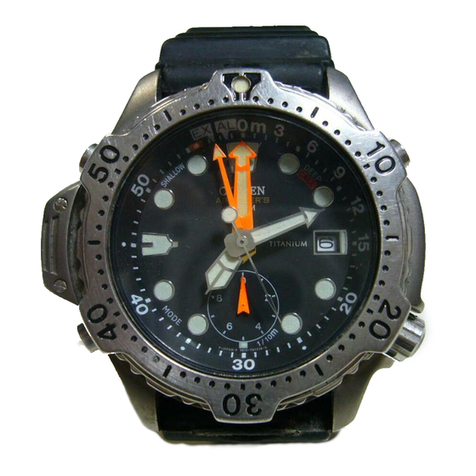
Citizen
Citizen 5810 Manual

Citizen
Citizen MIYOTA GP52 User manual
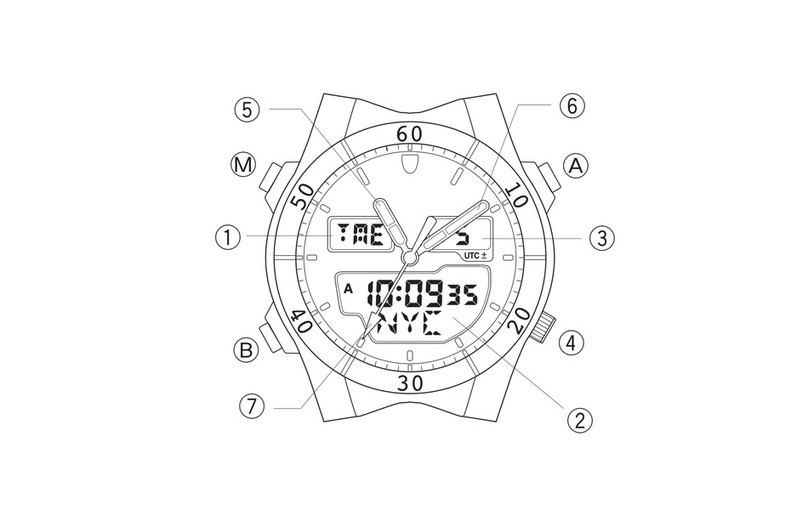
Citizen
Citizen U040 User manual

Citizen
Citizen 0S80 User manual
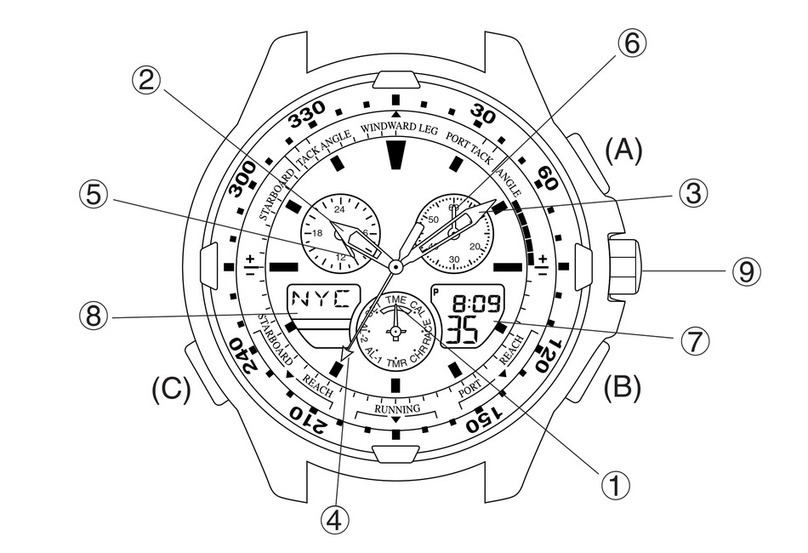
Citizen
Citizen C660 User manual
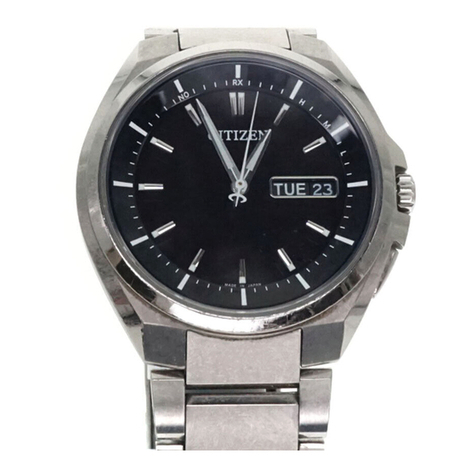
Citizen
Citizen H100 User manual
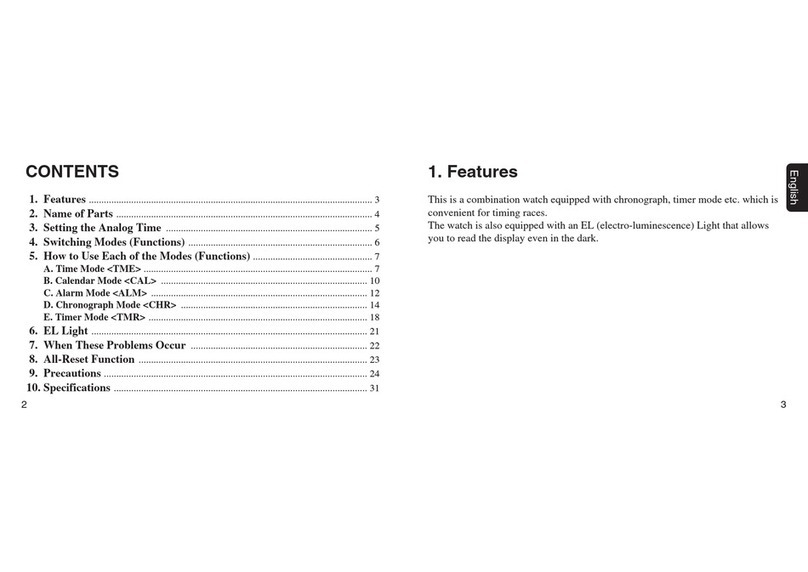
Citizen
Citizen C45 User manual
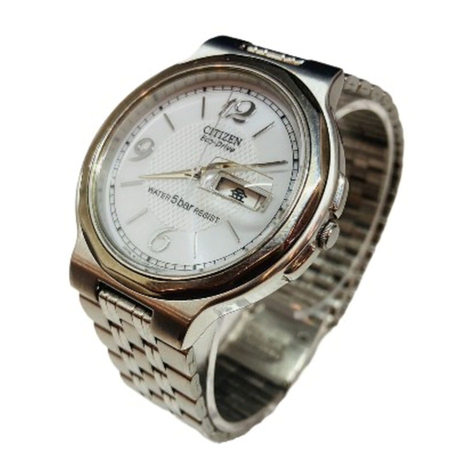
Citizen
Citizen E761 Operating manual
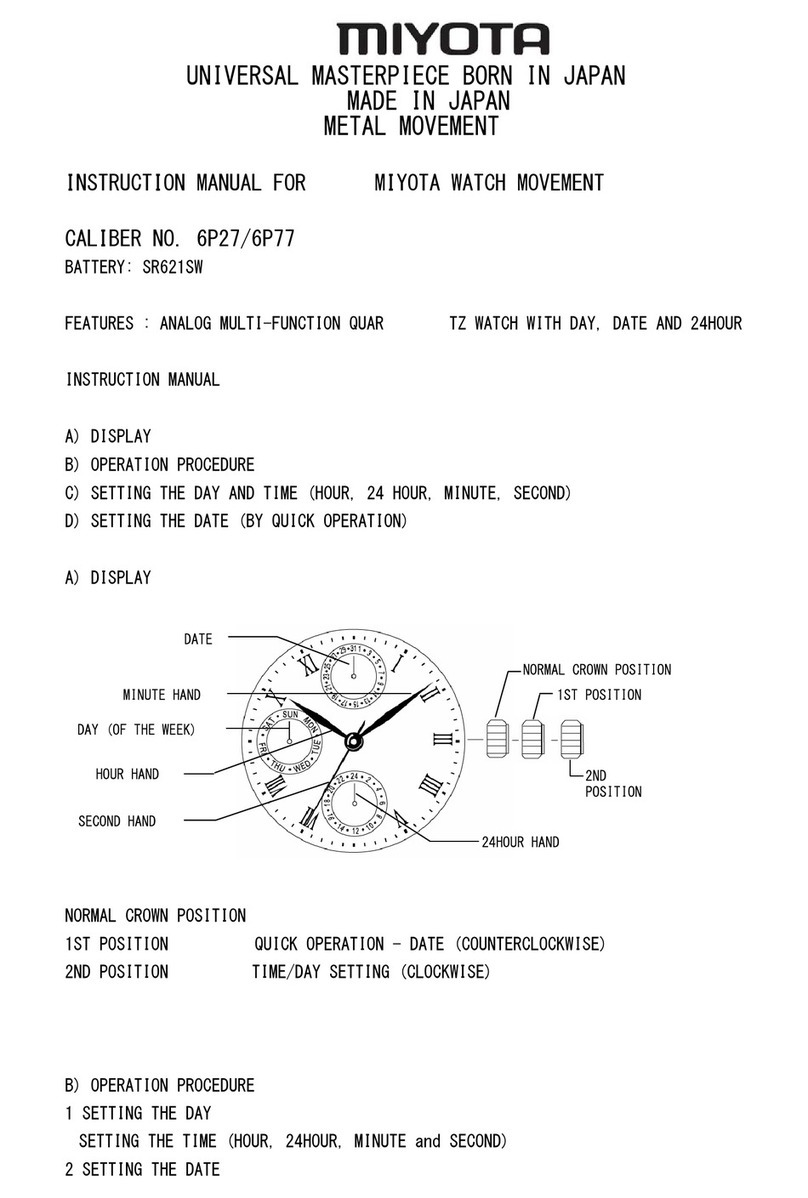
Citizen
Citizen 6P27 User manual

Citizen
Citizen J304 User manual

Citizen
Citizen 0S21 User manual
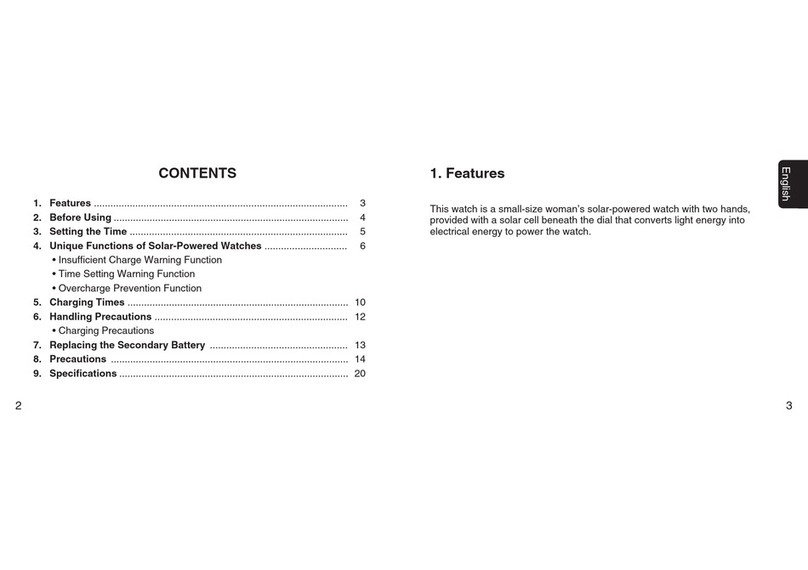
Citizen
Citizen G67X User manual
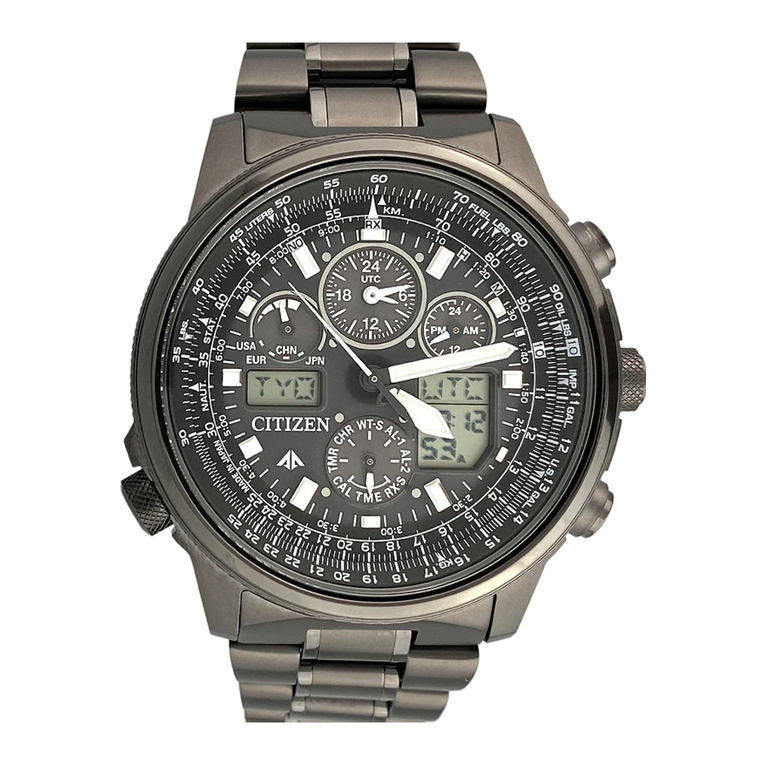
Citizen
Citizen Promaster Skyhawk A-T User manual

Citizen
Citizen Promaster 1000M Professional Diver User manual
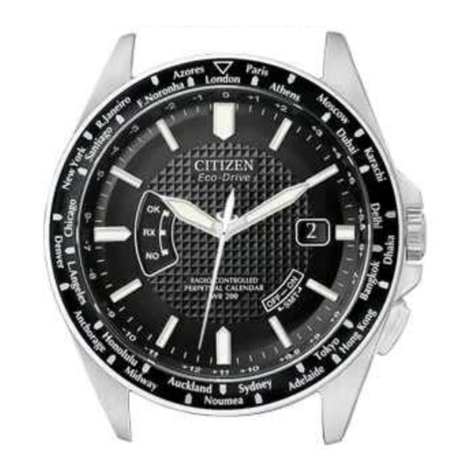
Citizen
Citizen H145 User manual

Citizen
Citizen Eco-Drive User manual
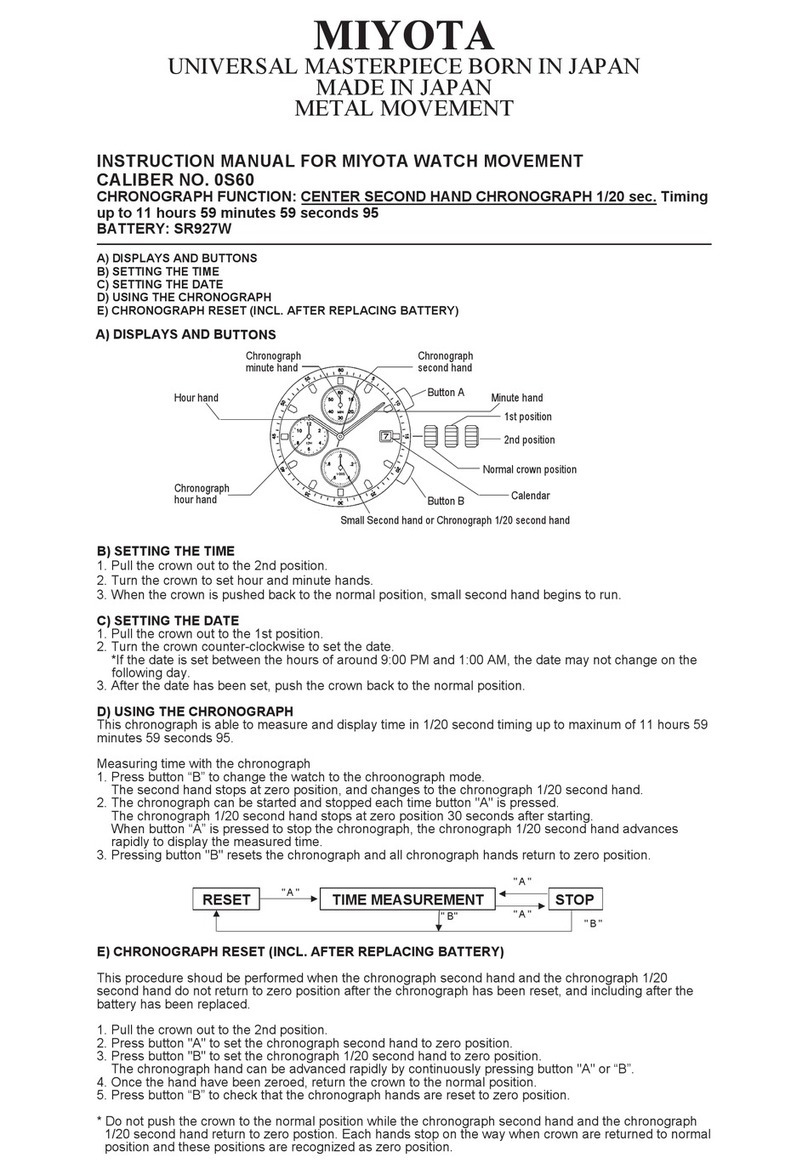
Citizen
Citizen 0S60 User manual
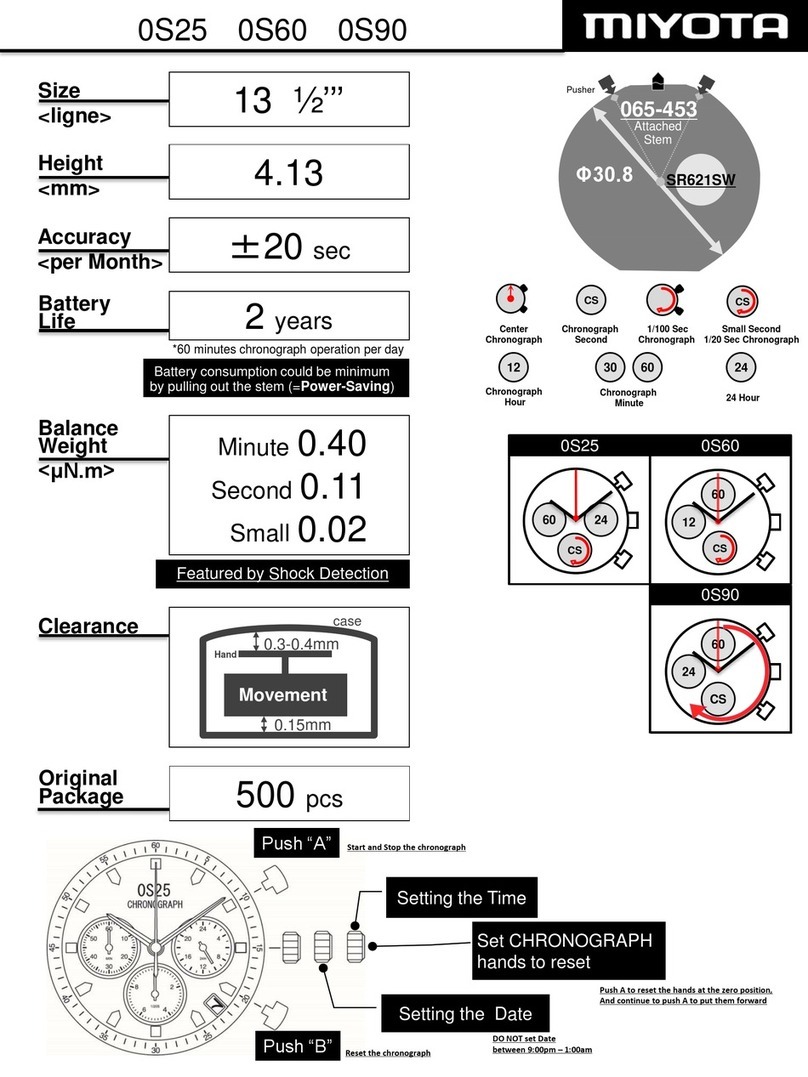
Citizen
Citizen 0S60 User manual

